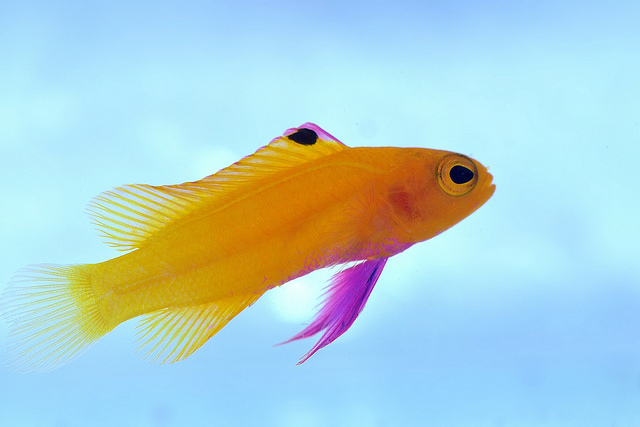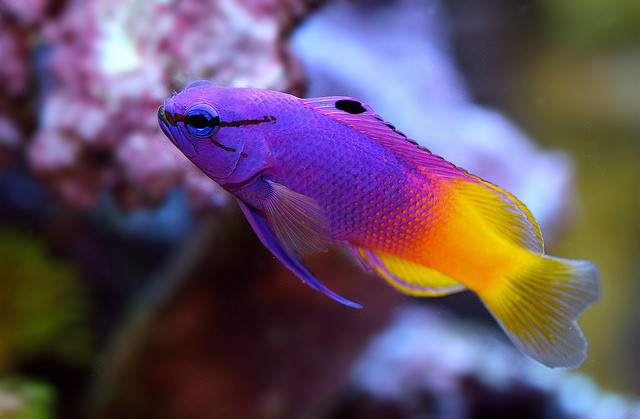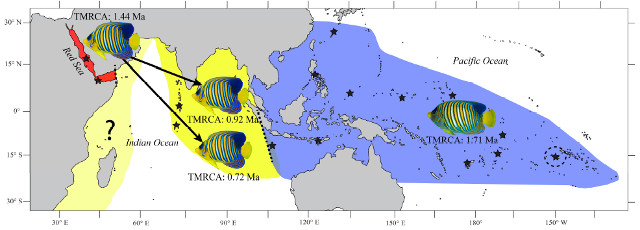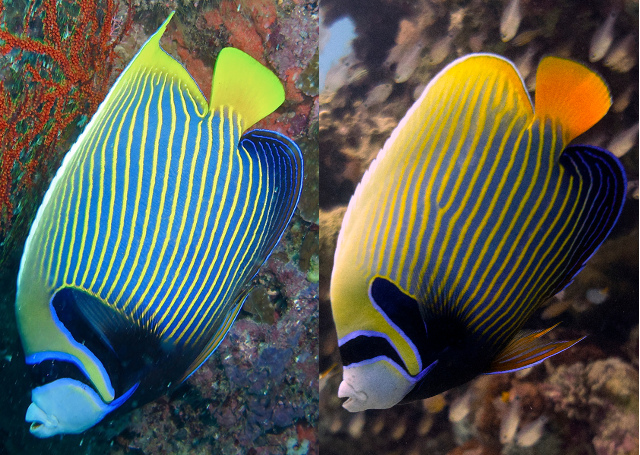 Scott McLaughlin, an 18 year old from Illinois, went on a fishing trip with his dad in the Sea of Cortez and caught quite the rare shark. McLaughlin was on the boat of Jaime Rendon, the Captain of Dr. Pescado. “I asked our guide what it was, and he said he had never seen anything like it in 25 years of doing this,” McLaughlin said. “We kept it out of the water for about 10 minutes before releasing it. The guide was concerned it might be endangered.” The shark was later identified from the photos by David Ebert, program director for the Pacific Shark Research Center of Moss Landing Marine Laboratories, as an albino or leucistic swell shark. Swell sharks are common in the Gulf of Mexico and harmless to humans. This spotted shark usually resides under reef crevices and is not sought after by fisherman based on it’s poor flesh quality. The shark gets its name because when it is threatened, it can swell up to double its normal size. This particular shark was unusual since it was affected by leucism or albinism. Leucism is a condition that is caused by a lack of many different pigments, while albinism is a condition that is caused by the absence of just one pigment, melanin. “There are about 520 species of sharks, and I’ve seen albino or leucistic ones in some of those, but this was the first time seeing an albino or leucistic form of a swell shark,” Ebert said. MORE… More:
Scott McLaughlin, an 18 year old from Illinois, went on a fishing trip with his dad in the Sea of Cortez and caught quite the rare shark. McLaughlin was on the boat of Jaime Rendon, the Captain of Dr. Pescado. “I asked our guide what it was, and he said he had never seen anything like it in 25 years of doing this,” McLaughlin said. “We kept it out of the water for about 10 minutes before releasing it. The guide was concerned it might be endangered.” The shark was later identified from the photos by David Ebert, program director for the Pacific Shark Research Center of Moss Landing Marine Laboratories, as an albino or leucistic swell shark. Swell sharks are common in the Gulf of Mexico and harmless to humans. This spotted shark usually resides under reef crevices and is not sought after by fisherman based on it’s poor flesh quality. The shark gets its name because when it is threatened, it can swell up to double its normal size. This particular shark was unusual since it was affected by leucism or albinism. Leucism is a condition that is caused by a lack of many different pigments, while albinism is a condition that is caused by the absence of just one pigment, melanin. “There are about 520 species of sharks, and I’ve seen albino or leucistic ones in some of those, but this was the first time seeing an albino or leucistic form of a swell shark,” Ebert said. MORE… More:
The post Teen Catches Rare Swell Shark appeared first on Reefs.com.

 Monterey Bay Aquarium’s newest exhibit explores the wonders of Baja California, a diverse state in northwestern Mexico, with geography ranging from beaches and deserts to forests. The ‘Viva Baja! Life on the Edge’ special exhibition is now open and features creatures from the coastal habitats of Baja, California. This is also the first time the aquarium has also featured animals that live entirely on land in its 32 year history! The tortoises especially seem to be a hit with visitors.“They’ve been crawling all over each other and everything else,” said Paul Clarkson, curator of husbandry operations, who added that the reptiles have been extremely popular with visitors.The exhibit also features many fish and invertebrates too. Some of the featured animals from Baja’s coastal deserts, mangrove forests and coral reefs include: Bluespotted jawfish; Cortez rainbow wrasse; Desert tortoise; Golden Trevally; Lookdown; Mountain kingsnake; Pacific seahorse; Green moray and the Staghorn hermit crab. The exhibition cost 3.8 million dollars and plans to run for at least two years. The exhibition includes three main galleries with 18 live displays, including interactive displays like the ‘rainbow reef’, where visitors get the chance to color a coral reef fish and email a copy to themselves as a keep sake. The first gallery, ‘Near the Edge’ focuses on the Sonoran Desert. The second gallery, ‘At the Edge’, features the wonders of the Mangrove Forest. The third and final gallery, ‘Over the Edge’, highlights the areas amazing coral reefs. The exhibit takes visitors through the vast and changing landscapes of Baja. “Baja is a unique and special place,” said Raúl Nava, senior exhibit developer and writer at the aquarium. “It’s an amazing land of contrasts.”
Monterey Bay Aquarium’s newest exhibit explores the wonders of Baja California, a diverse state in northwestern Mexico, with geography ranging from beaches and deserts to forests. The ‘Viva Baja! Life on the Edge’ special exhibition is now open and features creatures from the coastal habitats of Baja, California. This is also the first time the aquarium has also featured animals that live entirely on land in its 32 year history! The tortoises especially seem to be a hit with visitors.“They’ve been crawling all over each other and everything else,” said Paul Clarkson, curator of husbandry operations, who added that the reptiles have been extremely popular with visitors.The exhibit also features many fish and invertebrates too. Some of the featured animals from Baja’s coastal deserts, mangrove forests and coral reefs include: Bluespotted jawfish; Cortez rainbow wrasse; Desert tortoise; Golden Trevally; Lookdown; Mountain kingsnake; Pacific seahorse; Green moray and the Staghorn hermit crab. The exhibition cost 3.8 million dollars and plans to run for at least two years. The exhibition includes three main galleries with 18 live displays, including interactive displays like the ‘rainbow reef’, where visitors get the chance to color a coral reef fish and email a copy to themselves as a keep sake. The first gallery, ‘Near the Edge’ focuses on the Sonoran Desert. The second gallery, ‘At the Edge’, features the wonders of the Mangrove Forest. The third and final gallery, ‘Over the Edge’, highlights the areas amazing coral reefs. The exhibit takes visitors through the vast and changing landscapes of Baja. “Baja is a unique and special place,” said Raúl Nava, senior exhibit developer and writer at the aquarium. “It’s an amazing land of contrasts.” 







 With summer fast approaching, you may be looking for a place to take the kids for a vacation. Why not get your aquarium fix in at the same time? One place that is sure to be on my must see aquarium list is the Texas State Aquarium, which has just installed the longest acrylic window in the United States for it’s new H-E-B Caribbean Shark exhibit. The exhibit is part of the Caribbean Journey Exhibit, a 70,000 square foot, $55 million dollar expansion. The H-E-B Caribbean shark exhibit will feature over a dozen large sharks and a multitude of marine fish, and will be the focus point of the Caribbean Journey. Coming in at 759 square feet, the panel weighs over 42,000 pounds and is nine inches thick. This enormous viewing panel is actually made up of eight smaller panels, that are chemically bonded, making the seams nearly invisible. The panel was manufactured by Reynolds Polymer Tech of Grand Junction, Colorado, one of just a handful of suppliers of acrylic viewing windows for public aquariums. If you walk through an aquarium tunnel somewhere in the world, there is a good chance it was made by these guys. Next time you are beside a similar panel at your favorite aquarium, look closely and see if you can detect the seams.
With summer fast approaching, you may be looking for a place to take the kids for a vacation. Why not get your aquarium fix in at the same time? One place that is sure to be on my must see aquarium list is the Texas State Aquarium, which has just installed the longest acrylic window in the United States for it’s new H-E-B Caribbean Shark exhibit. The exhibit is part of the Caribbean Journey Exhibit, a 70,000 square foot, $55 million dollar expansion. The H-E-B Caribbean shark exhibit will feature over a dozen large sharks and a multitude of marine fish, and will be the focus point of the Caribbean Journey. Coming in at 759 square feet, the panel weighs over 42,000 pounds and is nine inches thick. This enormous viewing panel is actually made up of eight smaller panels, that are chemically bonded, making the seams nearly invisible. The panel was manufactured by Reynolds Polymer Tech of Grand Junction, Colorado, one of just a handful of suppliers of acrylic viewing windows for public aquariums. If you walk through an aquarium tunnel somewhere in the world, there is a good chance it was made by these guys. Next time you are beside a similar panel at your favorite aquarium, look closely and see if you can detect the seams.  Recently, a Canadian court ruled that the documentary film, Vancouver Aquarium Uncovered would not be removed from the internet, and that the film’s only flaw, was using the aquarium’s copyrighted photos in the film.
Recently, a Canadian court ruled that the documentary film, Vancouver Aquarium Uncovered would not be removed from the internet, and that the film’s only flaw, was using the aquarium’s copyrighted photos in the film. It’s without a doubt, that films
It’s without a doubt, that films  Although this creepy film was captured last April, off the coast of Panama, the footage has just been released. Scientists were investigating the complex phenomena that causes thousands of tuna crabs to swarm in the same direction. The video was captured over 1200 feet deep by an underwater vehicle. These tuna crabs are usually found in Southern California, and have never been found as far south as Panama. Although El Nino has been used an explanation for why these crabs have previously appeared in Northern California, researchers don’t believe El Nino is to blame for why they ended up in Panama.“It was unusual. In the past, we’ve noticed aggregations of breeding crabs hanging around the ocean floor, or migrating onto land if they’re terrestrial,” Jesús Pineda, a researcher at the Woods Hole Oceanographic Institute (WHOI) told Motherboard. “But these particular crabs weren’t responding to food, or migrating, or reproducing. This was something different.” According to scientists, the pattern of the crab swarm is highly unusual for crabs, and more commonly seen in insects. The scientists plan to return to Panama to try and figure out what the swarm of crabs were doing and what role, if any, this may play for the ecosystem at large.
Although this creepy film was captured last April, off the coast of Panama, the footage has just been released. Scientists were investigating the complex phenomena that causes thousands of tuna crabs to swarm in the same direction. The video was captured over 1200 feet deep by an underwater vehicle. These tuna crabs are usually found in Southern California, and have never been found as far south as Panama. Although El Nino has been used an explanation for why these crabs have previously appeared in Northern California, researchers don’t believe El Nino is to blame for why they ended up in Panama.“It was unusual. In the past, we’ve noticed aggregations of breeding crabs hanging around the ocean floor, or migrating onto land if they’re terrestrial,” Jesús Pineda, a researcher at the Woods Hole Oceanographic Institute (WHOI) told Motherboard. “But these particular crabs weren’t responding to food, or migrating, or reproducing. This was something different.” According to scientists, the pattern of the crab swarm is highly unusual for crabs, and more commonly seen in insects. The scientists plan to return to Panama to try and figure out what the swarm of crabs were doing and what role, if any, this may play for the ecosystem at large.